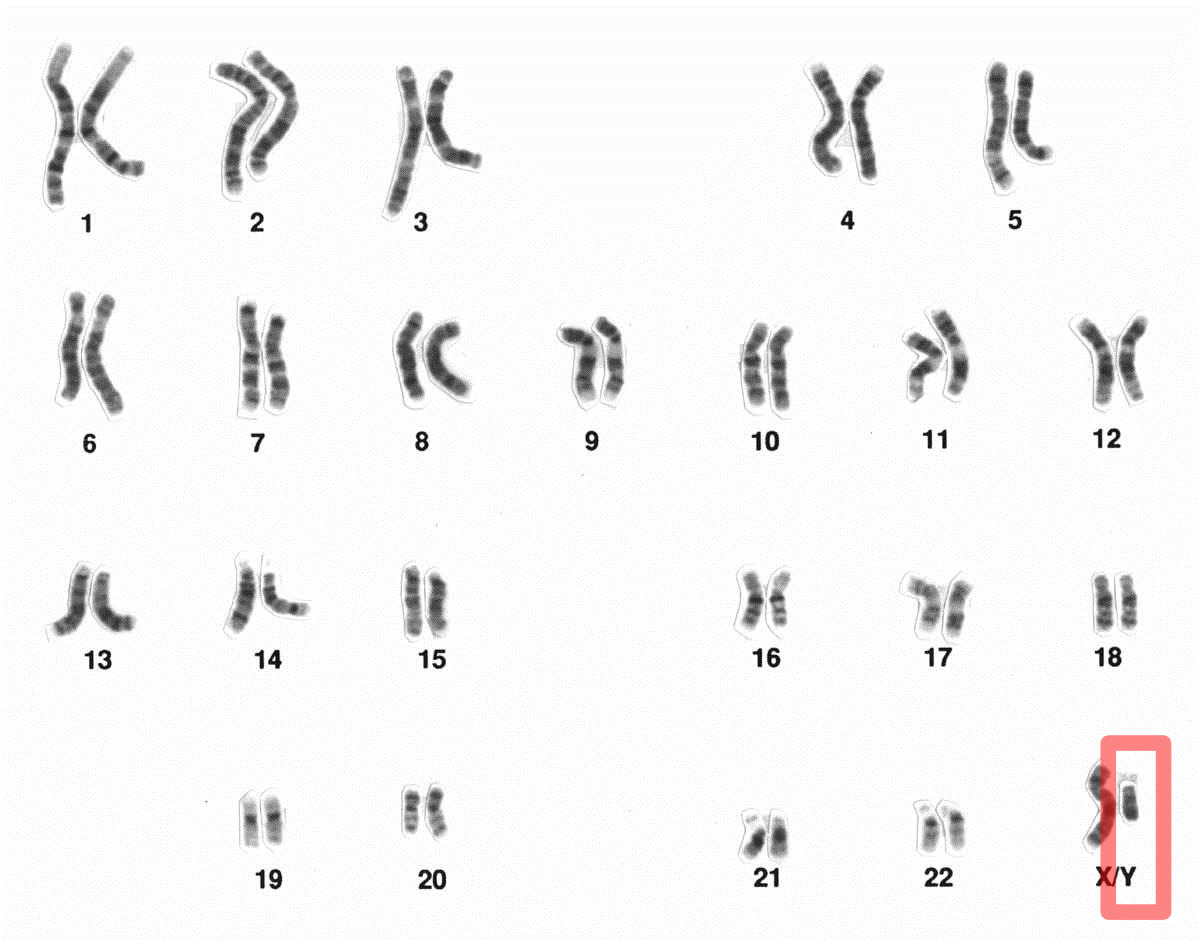Playlist
Show Playlist
Hide Playlist
Types of Sex
-
Slides Normal Puberty.pdf
-
Download Lecture Overview
00:01 Hi. Today, we’re going to talk about female puberty milestones. First, let’s talk about the different types of sex. There are three types of sex, genetic sex, gonadal sex, and phenotypic sex. 00:15 First, let’s talk about genetic sex. Genetic sex is your XX or XY; 46, XX being female, 46, XY being male. 00:26 That sex usually and typically determines your gonadal sex. Gonads can be either ovaries or testes. 00:33 Those ovaries or testes make hormones. The hormone production during fetal development or the hormone production during puberty will determine external phenotype. 00:44 Those differences will also be seen in the brain. During fetal production of hormones, you get sexual differentiation of the external genitalia. That leads to sex assignment at birth and gender rearing. While at puberty, secondary sexual development is due to the production of hormones either from the testes or ovaries which leads to gender identity. 01:10 I'd like to clarify on this slide that we are talking about genetic sex, which has nothing to do with gender identity. 01:17 Gender identity is an internal sense of being male, female, or along the spectrum, meaning non-binary as well. 01:27 So again, this slide is referring to what the cell's DNA component chromosomes are. 01:34 So that means that someone may be born XX or XY and they even may be phenotypically male or female. 01:43 This has nothing to do with their sense of gender or gender identity. 01:49 The genetic sex determination is made by again, XY in the male or XX in the female. 01:57 There are certain genes that are upregulated or downregulated depending on whether there is the presence of a Y. The Y chromosome encodes SRY. SRY will downregulate the genes that are important for female development, Wnt4 and Rspo1 and will upregulate Sox9, Fgf9 in the Sertoli cells. While in the female, Sox9 and Fgf9 are not present, therefore, Wnt4 and Rspo1 will be upregulated. This will lead to a female phenotype. In the gonad or in the ovaries of the female, oogenesis occurs. Oogenesis begins around the fourth week of gestational age. 02:43 Around the midgestation, around 20 weeks, you will see that oogonia, the cells that produce eggs will begin to make follicles. Those follicles will undergo a process called atresia or apoptosis or programmed cell death which will decrease the number of follicles that are present which will continue to decrease throughout the life of the female fetus. 03:08 Now, depending on whether or not you have Sertoli cells that make AMH or anti-Müllerian hormone, you will develop either paramesonephros in the female or mesonephros in the male. 03:23 We both though start out with an indifferentiated stage. In the female, paramesonephros equals the Müllerian duct. In the male, the mesonephros equals the Wolffian duct. 03:36 So normally in the female, you don’t have AMH produced by the Sertoli cells. 03:42 Therefore, you make fallopian tubes a uterus and the upper third of the vagina. 03:47 However, if you are male, you do produce AMH from the Sertoli cells. Those Sertoli cells inhibit Müllerian development or paramesonephros. In the male, you will see mesonephric ducts which lead to the epididymis, the vas deferens, and the urethra. Now, if your gonads produce testosterone or estrogen, that will make your phenotypic sex or the sex that you show with your external differentiated genitalia. In the female, the glans penis will become the clitoris. 04:23 The labioscrotal ridge will actually not fuse and there will be an introitus for the vagina. 04:30 You will have a labia minora and a labia majora. However in the male, testosterone, DHT to be specific causes the glans to become the penis. You will see that the labioscrotal swellings will become the scrotum and that there will be a fusion of the labioscrotal folds so that you have a penile raphe. 04:51 In the female fetus in the first trimester, germ cell migration occurs. You can also see that there is development of the external genitalia. The Wolffian ducts should degenerate leading then to the second trimester. There is development of a uterus and onto the vagina. 05:10 Now, let’s look at male development. In the first trimester, you see that there is germ cell migration, spermatogenic cords. There’s also Leydig cell development which will make testosterone. 05:21 There’s differentiation of the external genitalia. There’s also Wolffian duct differentiation. 05:26 Remember that the paramesonephros or the Müllerian ducts will regress. You see here in the second trimester that we have testosterone synthesis. That will cause the growth of the external genitalia and the descent of the testes from the abdomen into the scrotum. 05:44 Normally, you’ll see pediatricians will check for the descent of testes at the time of birth.
About the Lecture
The lecture Types of Sex by Lynae Brayboy, MD is from the course Normal Puberty and Disorders of Sexual Development.
Included Quiz Questions
Which of the following dictates the determination of gonadal sex (testes, ovaries) in an individual?
- Genetic sex (XX, XY)
- Hormone production during fetal development
- Hormone production during puberty
- Gender identity
- None of the options are correct
Which of the following is TRUE regarding genetic sex determination?
- SRY down-regulates Wnt4 and Rspo1.
- SRY down-regulates SOX 9 and Fgf9.
- SRY acts on the granulosa cells.
- XX acts on sertoli cells.
- XX up-regulates SOX9 and FGF9.
Which of the following correctly describe the mechanisms involved in the formation of the male phenotype?
- Wnt 4 - down-regulated in Sertoli cells Rspo1 - down-regulated in Sertoli cells Sox9 - up-regulated in Sertoli cells Fgf9 - up-regulated in Sertoli cells
- Wnt 4 - down-regulated in Sertoli cells Rspo1 - up-regulated in Sertoli cells Sox9 - up-regulated in Sertoli cells Fgf9 - down-regulated in Sertoli cells
- Wnt 4 - up-regulated in Sertoli cells Rspo1 - up-regulated in Sertoli cells Sox9 - down-regulated in Sertoli cells Fgf9 - down-regulated in Sertoli cells
- Wnt 4 - up-regulated in Sertoli cells Rspo1 - down-regulated in Sertoli cells Sox9 - down-regulated in Sertoli cells Fgf9 - up-regulated in Sertoli cells
- Wnt 4 - down-regulated in Sertoli cells Rspo1 - up-regulated in Sertoli cells Sox9 - down-regulated in Sertoli cells Fgf9 - up-regulated in Sertoli cells
When does development of the follicles occur in the oogonia of a fetus?
- 20 weeks gestation
- 14 weeks gestation
- 24 weeks gestation
- 32 weeks gestation
- 8 weeks gestation
Which of the following statements is FALSE regarding sex determination of the fetus?
- The Leydig cells produce anti-Mullerian hormone.
- The paramesonephros helps in the formation of the fallopian tubes, uterus and upper one-third of the vagina in females.
- The mesonephros helps in the formation of external male genitalia.
- The glans penis in the females forms the clitoris.
- The DHT helps in the formation of the penis.
Which of the following statements is TRUE regarding the development of sexual organs?
- Spermatogenic cords are developed in the first trimester in males.
- Germ cell migration occurs in the 2nd trimester.
- Wolffian duct regresses during the development of male genitalia.
- Müllerian duct regresses in the formation of female genitalia.
- Testosterone synthesis occurs in the first trimester in males.
Customer reviews
3,0 of 5 stars
| 5 Stars |
|
1 |
| 4 Stars |
|
0 |
| 3 Stars |
|
0 |
| 2 Stars |
|
0 |
| 1 Star |
|
1 |
Inclusion of the "gender identity" update was unscientific and does not belong in a medical lecture.
This class was really hard to memorize for me, and to answer the questions even more. But the explanation was very clear thanks. After 3 times of repetition i was abble to answer the questions.





